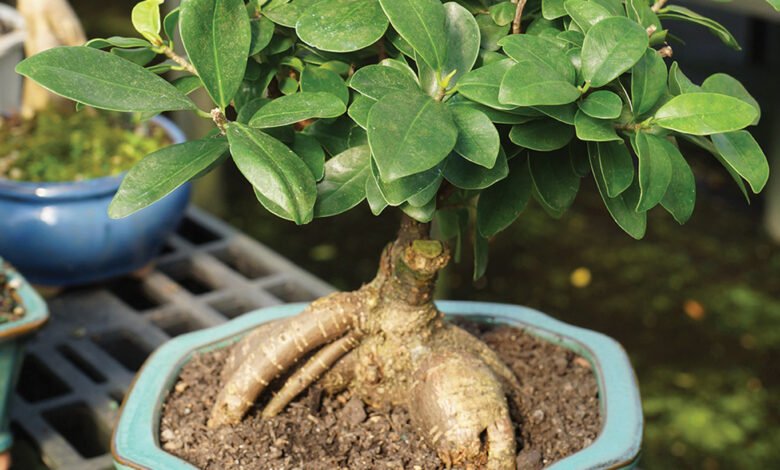
Ficus microcarpa, commonly known as the Indian Laurel Fig, Chinese Banyan, or Curtain Fig, is a versatile and popular species of the Ficus genus. Native to Southeast Asia and Australia, this plant is renowned for its adaptability and unique aesthetic appeal. Whether cultivated as a dramatic outdoor tree or as a bonsai-style indoor plant, Ficus microcarpa captures attention with its lush foliage, intricate root structures, and ability to thrive in various environments.
Key Features of Ficus Microcarpa
Ficus microcarpa is a member of the Moraceae family and shares similarities with other well-known Ficus species like the Ficus benjamina (Weeping Fig) and Ficus elastica (Rubber Tree). However, it has distinct characteristics that set it apart:
- Glossy Leaves
The plant boasts small, oval-shaped leaves that are shiny and deep green, making it an attractive choice for both landscaping and interior decor. - Unique Root System
In its natural habitat, Ficus microcarpa develops impressive aerial roots that cascade from its branches to the ground, creating a dramatic and iconic banyan tree appearance. - Compact Growth
When cultivated as an indoor plant or bonsai, it maintains a manageable size, making it ideal for small spaces. - Fruiting
The plant produces tiny, round figs, though these are usually insignificant and may not form indoors unless the plant is exposed to specific environmental conditions.
Natural Habitat and Growth Pattern
In the wild, Ficus microcarpa thrives in tropical and subtropical regions, where it grows into large, majestic trees often used for shade or ornamental purposes. It is also an epiphytic species, meaning it can grow on other plants or structures, sending roots down to the soil over time.
When grown indoors, it adapts well to pot cultivation, often pruned and trained into a bonsai shape. Its resilience and ability to withstand pruning make it a favorite for bonsai enthusiasts.
Uses of Ficus Microcarpa
Ficus microcarpa is valued for various purposes:
- Landscaping
Outdoors, it is used as a shade tree, windbreak, or ornamental centerpiece in parks and gardens. Its large canopy and dense foliage provide excellent coverage. - Indoor Plant
As a houseplant, Ficus microcarpa adds greenery and elegance to interiors. Its compact growth habit and easy maintenance make it a great choice for homes and offices. - Bonsai Cultivation
One of the most popular uses of Ficus microcarpa is in bonsai art. Its ability to tolerate extensive pruning and root manipulation makes it ideal for creating intricate bonsai designs.
Caring for Ficus Microcarpa
Caring for Ficus microcarpa is relatively straightforward, making it suitable for beginners and experienced plant owners alike. Here’s a breakdown of its care needs:
- Light Requirements
Ficus microcarpa thrives in bright, indirect light but can tolerate lower light conditions. When grown outdoors, it prefers partial shade to full sunlight. Indoors, place it near a well-lit window. - Watering
Keep the soil consistently moist but not waterlogged. Allow the top inch of soil to dry before watering again. Overwatering can lead to root rot, so ensure the pot has adequate drainage. - Temperature and Humidity
As a tropical plant, Ficus microcarpa prefers temperatures between 60-75°F (16-24°C) and moderate to high humidity. Avoid exposing it to sudden drafts or extreme temperature fluctuations. - Soil and Fertilization
Use a well-draining soil mix for container-grown plants. During the growing season (spring and summer), feed the plant with a balanced liquid fertilizer every 4-6 weeks. Reduce feeding in fall and winter when growth slows. - Pruning and Shaping
Regular pruning helps maintain the desired shape and size of Ficus microcarpa. Trim back overgrown branches or leaves to encourage new growth and keep the plant looking tidy.
Common Issues and Solutions
- Yellowing Leaves: This could be due to overwatering or insufficient light. Adjust watering habits and reposition the plant if necessary.
- Pests: Watch for common pests like spider mites, scale, and mealybugs. Treat infestations with insecticidal soap or neem oil.
- Leaf Drop: Sudden changes in environment, such as relocation or temperature shifts, can cause leaf drop. Maintain consistent care to reduce stress on the plant.
Ficus Microcarpa in Feng Shui and Culture
In many cultures, Ficus microcarpa is considered a symbol of prosperity, longevity, and protection. Its lush foliage and enduring growth make it a popular choice for feng shui practitioners, who believe it attracts positive energy and balance to a space.

